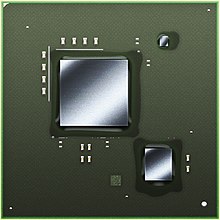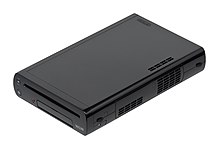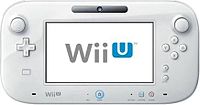Wii U
 | |
 Wii U控制器与Wii U主机 | |
| 研发商 | 任天堂综合开发本部 |
|---|---|
| 制造商 | 富士康[1] 三美电机 任天堂 |
| 类型 | 家用游戏机 |
| 产品世代 | 第八世代 |
| 发布日期 | |
| 生命周期 | 2012年-2017年 |
| 停产日期 | 全球:2017年1月31日 |
| 销售台数 | 全球:1,356万部[4] |
| 媒体 | 12公分25GB容量Wii U专用高密度光盘[5] 12公分Wii光盘 |
| 中央处理器 | IBM Power Espresso多核心处理器[6] |
| 硬盘储存空间 | 内置闪存 SD记忆卡、SDHC USB储存装置 |
| 显示 | 视频输出格式 |
| 图形处理器 | 550 MHz AMD Radeon Latte[8][9][10] |
| 音效 | 音频输出格式
|
| 控制器输入 | Wii U控制器 Wii遥控器 传统控制器 Wii平衡器 GameCube手柄 |
| 连接接口 | 4 × USB 2.0[11] |
| 在线服务 | 任天堂网络 任天堂eShop Miiverse |
| 最畅销游戏 | 《马力欧卡丁车8》 840万套 (全球,截止2017年12月) |
| 向下兼容 | Wii |
| 前代机种 | Wii |
| 后继机种 | 任天堂Switch |
Wii U是任天堂继Wii之后所推出的家用游戏主机,是Wii的后继机种[12]。于2011年6月7日首次公布,开发代号为“Project Café”。
Wii U于2012年11月18日在北美最先发售,提供两款套装选择,分别为标准版套装,售价为299.99美元(内置8GB闪存)及豪华版套装,售价为349.99美元(内置32GB闪存);2012年12月8日在日本发售,同样提供两款套装选择,分别为标准版套装,售价为26,250日圆(内置8GB闪存)及豪华版套装,售价为31,500日圆(内置32GB闪存)[13]。除此之外,Wii U亦有先后在墨西哥、南非、欧盟、澳大利亚、巴西等国家和地区推出。
Wii U是任天堂历史上第一部支持分辨率1080p的家用游戏主机,它配有2GB的RAM并将一半用于Wii U的操作系统[14]。 Wii U控制器(Wii U GamePad)是该游戏机最主要的控制器,搭配了液晶显示器并带有触控功能,集合了传统游戏控制器和平板电脑的特点。除了拓展游戏上的玩法之外,亦可让玩家在电视上播放其他内容时,仍能利用控制器继续游戏。作为Wii的后继机种,Wii U可以完全向下兼容所有Wii上的游戏和大多数配件,不过在画质输出上仍旧为480p,并且必须搭配Wii遥控器进行游戏。
由于和竞争对手同期所推出的游戏机相比缺乏第三方游戏厂商的支持,致使Wii U在游戏阵容上呈现不足,这导致了Wii U在市场上的表现不佳。Wii U在生命周期中的销量仅有大约1,356万,远逊于前一代主机Wii(Wii的销量超过1亿)[4]。随着2016年10月任天堂宣布下一代游戏主机任天堂Switch即将推出,同年11月,任天堂率先在日本宣布将停产Wii U[15],并将资源开发集中在任天堂Switch上。2017年1月31日,任天堂宣布正式在全球停产Wii U[16],而Wii U也成为了任天堂历史上生命周期第三短的电子游戏机(第二是Panasonic Q,第一是Virtual Boy)。
主机历史
[编辑]Wii U主机最早在2008年开始规划[17], 在任天堂了解Wii面临的一些限制和挑战之后,例如Wii在市场大众认知的印象中是主要面向“轻度”玩家而设计的主机[18]。任天堂要由Wii U来吸引“核心”玩家[19]。游戏设计者宫本茂认为Wii在高清影像和网络联机能力有所缺乏,让Wii的游戏画面无法充分表现[20]。因此任天堂决定新主机必须要有重大的架构性改进。
对于新主机的想法,在任天堂内部中有着许多不同的意见,而整个计划曾经过多次的重新来过或大幅修改[21]。控制器内置触控屏幕的构想原始是来自Wii主机上用来提示新消息的蓝色指示灯[22]。宫本茂和他的团队想要用尺寸较小的屏幕来向玩家提供游戏的回馈信息和提示消息。在开发后期,这个构想获扩展成一个可以显示完整游戏内容的屏幕,同样的构想在开发前期就已提出,但当时因预算的考量而作罢[23]。

硬件
[编辑]在2012年9月13日的任天堂直面会(ニンテンドーダイレクト)视频中,任天堂宣布Wii U在发售时将会推出黑白两种颜色。白色版本内置8 GB闪存的储存空间,在日本和PAL区称为“Basic Pack”,在北美洲则称为“Basic Set”。黑色版本则内置32 GB的闪存,在日本和PAL区称为“Premium Pack”,在北美洲则称为“Deluxe Set”。日本在2013年7月13日推出了白色版本的Premium Pack主机[24]。
主机
[编辑]

Wii U使用了由AMD、IBM和瑞萨电子与任天堂合作开发的特制多芯片模组(MCM),其结合了中央处理器(CPU)、图形处理器(GPU)以及EEPROM内存控制器[25]。代号为“Espresso”的中央处理器是由IBM设计[10],以PowerPC 750(与苹果电脑PowerPC G3处理器系出同门)为基础的三核心架构,主频为1.24 GHz[26]。IBM形容这是一款“全新的Power架构微处理器”[27],其采用多核心设计、45奈米制程生产,并包含了一个未知大小的eDRAMCPU缓存。这款处理器是由IBM位于纽约州的300毫米半导体工厂生产制造[27]。图形处理器则由AMD设计,包括了一个含320个流处理器规格近于HD 4670的AMD Radeon High Definition处理器,以及34 MB的内置eDRAM缓存[25],主频为550 MHz[26]。主机中另有一个次要特制处理器,但该处理器的工作内容用途并未公开,这些工作是在游戏进行中或主机处于睡眠模式时于背景进行。主机内也包含了一个专门负责音频处理的数字信号处理器(DSP)模组。
Wii U内装有2 GB DDR3系统内存,由四组512 MB DRAM芯片组成,最大带宽为每秒12.8 GB,其中1 GB保留专供操作系统使用,游戏软件无法取用。Wii U的内存容量是Wii的20倍[28]。图形处理器也内含35 MB eDRAM缓存内存。内存的设计架构让中央处理器和图形处理器都能存取主要的DDR3及eDRAM内存空间,因此无需再另外区分出两种不同用途的内存空间[29]。
主机内置的只读光驱能以5x恒定角速度(CAV)读取专用的高密度Wii U光盘(每层25 GB),其与蓝光光盘的读取方式类似[30][31],资料传输速度最高为每秒22.5MB。此外光驱也具有向下兼容能力,可以6x恒定角速度读取Wii光盘。为了进一步增强光驱的性能,Wii U与前代主机一样都使用了Zlib解压缩方式。目前未知光驱是否能够读取双层50 GB的Wii U光盘。主机内置8 GB(Basic)或32 GB(Premium/Deluxe)的闪存储存空间,可通过链接SD卡或USB外接硬盘来扩充,最大可支持2 TB的容量[32][33]。
Wii U具有802.11 b/g/n无线网络与以太网路联机能力,并支持蓝牙4.0,机身配置四个USB 2.0连接端口(主机前后各两个),以及一个SD卡插槽(最高支持至SDHC卡)。此外并有额外的电源线连接端口可为Wii感应条提供电力。影像输出支持1080p、1080i、720p、576i、480p和480i多种格式,通过HDMI 1.4和色差端子(与D端子)与电视链接,此外576i、480i(标准4:3和16:9宽屏幕)可通过AV端子(S端子、RGB SCART和D端子)传送信号。音频输出支持六个频道的5.1声道环绕音效以及立体声。主机也支持输出立体3D图像和视频[10]。
控制器
[编辑]Wii U的主要控制器是Wii U控制器,每台主机最多可与两台Wii U控制器链接[34]。此外,主机也同时支持最多四支Wii遥控器(包括Plus、双节棍控制器和传统控制器)或Wii U Pro控制器[35]。 主机亦支持Wii平衡器和其他所有的Wii官方周边产品(例如方向盘或光线枪等)。《任天堂明星大乱斗3DS/Wii U》的Wii U版附带了任天堂GameCube手柄和转接器,以满足核心玩家对操控的需求。

Wii U控制器
[编辑]
随附在主机包装内的Wii U控制器是Wii U主要的控制器。控制器正面配置有一个6.2吋(15.7公分)16:9的电阻式触控屏幕,可作为游戏内容的扩充功能显示,亦可直接镜像显示电视上的游戏画面。控制器另内置一个正面相机镜头、麦克风、立体声扬声器和近场通信(NFC)感应器[36]。Wii U控制器内装有九轴动作感应装置,是由三轴加速规、三轴陀螺仪和三轴磁强计组成,并加入了震动机能[37]。控制器内配置有一个可拆卸、可重复充电的锂离子电池,能储存1500毫安时(mAh)的电力,一次充电约可让控制器使用三至五小时。控制器重约500公克,尺寸为130 x 23 x 260厘米。Wii U控制器通过以IEEE 802.11n为基础的方式与Wii U主机链接,最高频率为5.2 GHz,并在技术上能支持无线网络延伸功能[38],可通过由博通和任天堂合作开发的专用通信协定和软件实现[39]。Wii U控制器无法在旧款Wii主机上使用。
技术规格
[编辑]处理器:
- CPU:IBM Power Architecture 多核心 45 nm 微型处理器,以IBM PowerPC750为基础而设计的[6][40]。
- GPU:定制的AMD Radeon HD[8] similar to the Radeon R700 chip[9]。
内存:
储存媒体:
连接端口和插槽:
Wii U控制器:
- 内置三轴加速感应器和三轴陀螺仪
- 喇叭和麦克风
- 摄影机
- 红外线感应条
- 6.2 吋(15.7 公分) 854×480 FWVGA 16:9 触控屏幕
- 两个类比摇杆和一个十字钮
- 触控笔
- 选择(Select)、开始(Start)、主菜单(Home)和电源按钮
- A/B/X/Y 按钮、L/R 按钮和 ZL/ZR板机按钮
- 控制器同步按钮
- 蓝牙
- 近场通信/FeliCa
- 重量:500克
备注:Wii U也支持Wii遥控器、双节棍控制器、传统控制器和Wii平衡器[44]。
视讯:
- 1080p、1080i、720p、480p或480i,标准4:3和16:9宽屏幕(anamorphic format)
- 复合输出端口支持复合端子、YPBPR色差端子、S-端子(仅限NTSC游戏机)、RGB SCART端子(仅限PAL游戏机)和D-Terminal(仅限日本)
- HDMI 1.4输出端口支持3D眼镜[43]
音频:
- 复合输出端口,HDMI六声道PCM线性输出
发售日及定价
[编辑]- 日本:2012年12月8日,26,250日圆(标准版,包5%销售税)及31,500日圆(豪华版,包税)
- 美国:2012年11月18日,299.99美元(标准版,不包税)及349.99美元(豪华版,不包税)
版本比较
[编辑]- 豪华版套装:黑色Wii U主机一部、Wii U控制器一个、HDMI连接线、AC充电器(Wii 和Wii U控制器)、充电直立架、Wii U控制器直立架、主机直立架(美版附送任天堂乐园)、Nintendo Network会员(将于2014年实行)
- 标准版套装:白色Wii U主机一部、Wii U控制器一个、HDMI连接线、AC充电器(Wii 和Wii U控制器)
游戏软件
[编辑]由于Wii U在硬件设计上与PlayStation和Xbox存在不少差异,造成第三方游戏厂商开发意愿低落,因此大多数的Wii U游戏都是由任天堂自行开发。
例如艺电(EA)在2013年5月宣布撤回对Wii U主机的支持,并没有任何正在开发的Wii U游戏[45],但数日后又改变说法表示“我们正在为任天堂的主机制作游戏,但数量与PlayStation和Xbox系统比起来要少上许多”[46]。在2013年的E3上,Ubisoft宣布直到Wii U主机销售数字增加以前,他们不会再推出任何Wii U主机的独家作品[47],而该公司在不久后又宣称他们依然是Wii U的“大支持者”,并计划在2013年继续推出多款Wii U游戏[48]。Bethesda Softworks在2013年7月表示他们没有任何为正在Wii U开发的游戏,公关与行销副主席比特·海因斯(Pete Hines)解释“这取决于我们正在制作的游戏作品是否能符合主机的特色,也取决于主机的硬件能否配合我们正在开发的作品。”[49]这段解释在之后得到进一步的澄清,表示主要的因素其实是在主机的硬件性能[50]。与其他公司不同的是,Activision表示他们会“竭尽所能”来支持Wii U主机,并会持续开发Wii U上的作品[51]。
2017年3月3日与任天堂Switch同步推出的《塞尔达传说 旷野之息》是任天堂在Wii U上推出的最后一款游戏[52]。
评价
[编辑]在发售后,Wii U同时获得了正反两面的评价。影音俱乐部网站的约翰·泰堤(John Teti)认为Wii U是一款能吸引目光但缺乏重点的主机,他并举例《任天堂大陆》是一款“概念为了服务科技而存在”的作品,单纯只是为了展现主机的特色[53]。Engadget的班·吉伯特(Ben Gilbert)虽然任天堂遵守诺言推出了一款“现代的高清游戏主机”,但也有着一些严重的缺点和不成熟的概念:朋友名单(Friends List)和Miiverse之间令人混淆的链接、缺少其他主机普遍包含的功能(群组聊天、成就奖杯系统、播放媒体光盘等),以及游戏控制器的电池仅能使用3.5小时,此外部分网络功能在上市时无法使用也让他无法对Wii U作出完整的评价[54]。TechRadar赞扬了Wii U控制器的功能以及高分辨率的画质,但也对控制器电池使用时间过短作出批评,并质疑在上市期间能刺激主机销售量的游戏作品太少[55]。部分游戏业界的人物认为Wii U并不算是第八世代的游戏主机,[56][57][58]而硬件能力则是主要的理由之一[59][60]。美国任天堂运营长雷吉·菲尔斯-埃米则指出Wii在2006年推出时也有类似的评论出现[61]。
销售成绩
[编辑]| 日期 | 日本 | 美国 | 其他 | 总计 | 增加 |
|---|---|---|---|---|---|
| 2012年12月31日[62] | 83 | 132 | 90 | 306 | 不适用 |
| 2013年3月31日[63] | 92 | 152 | 101 | 345 | 12.7% |
| 2013年6月30日[64] | 101 | 158 | 102 | 361 | 4.6% |
| 2013年9月30日[65] | 115 | 175 | 101 | 391 | 8.3% |
| 2013年12月31日[66] | 175 | 261 | 149 | 586 | 49.8% |
| 2014年3月31日[67] | 181 | 281 | 156 | 617 | 5.2% |
| 2014年6月30日[68] | 187 | 308 | 173 | 668 | 8.2% |
| 2014年9月30日[69] | 197 | 343 | 188 | 729 | 9.1% |
| 2014年12月31日[70] | 230 | 445 | 246 | 920 | 26.2% |
| 2015年3月31日[71] | 233 | 465 | 256 | 954 | 3.6% |
| 2015年6月30日[72] | 248 | 485 | 268 | 1001 | 4.9% |
| 2015年9月30日[73] | 266 | 521 | 287 | 1073 | 7.1% |
| 2015年12月31日[74] | 308 | 610 | 342 | 1260 | 17.4% |
| 2016年3月31日[75] | 313 | 620 | 347 | 1280 | 1.5% |
| 2016年6月30日[76] | 321 | 629 | 353 | 1302 | 1.7% |
| 2016年9月30日[77] | 330 | 641 | 365 | 1336 | 2.6% |
| 2016年12月31日[78] | 334 | 649 | 373 | 1356 | 1.4% |
截至2017年3月[update],Wii U全球销量已经超过1,356万台[4]。
根据NPD Group,Wii U在美国上市首周任天堂就将第一批库存的400,000台主机全部售出[79],整个11月总计售出425,000台主机[80]。而英国上市的第一个周末总计销售量为40,000台。[81]在日本,2012年12月间总计售出超过600,000台Wii U[82]。根据NPD Group,,Wii U主机在美国上市后的41天间总计售出890,000台[83]。在2013年4月至6月间的销售量为160,000台,比起前三个月(2013年1月至3月)的销售量下滑了51%[84]。
2013年1月Wii U在美国的销售量为57,000台[85]。相较之下,上一代的Wii在2007年1月售出了435,000台,同样也是上市后两个月的时间点[86]。由于Wii U在美国和其他地区的销售量低于预期,因此任天堂将2013财政年度的销售预测降低了17%,从550万美元调降至400万美元[87];Wii U最后在该财政年度总共卖出350万台[88]。在2013年7月末,沃尔玛在英国的子公司ASDA,同时也是该国第二大的连锁量贩店,宣布他们并没有销售Wii U主机的计划,但依然会销售Wii U的部分游戏[89]。而许多游戏零售商则持续强调他们对Wii U主机的支持,英国连锁游戏商店Game表示“我们完全支持所有的任天堂产品,包括Wii U”[90]。
停产
[编辑]2016年11月,任天堂日本更新了Wii U的页面,并表示Wii U的日版将会在近期停产。[15]2017年1月31日,任天堂宣布正式在全球停产Wii U[16]。
2024年4月9日,任天堂终止了Wii U的在线游玩及e-shop在线购物服务[91]。同年7月3日,任天堂宣布Wii U及周边设备已经终止官方维修服务,原因是更换必须的零件数量不足[92]。
参考资料
[编辑]- ^ iPhone, Wii U Manufacturer Admits to Employing Children. IGN. 2012-10-17 [2012-10-17]. (原始内容存档于2022-02-12).
- ^ WiiU美版11月18日发售 基础版300美元. [2012-09-13]. (原始内容存档于2022-01-05).
- ^ WiiU已确认12月8日发售:价格2W5和3W二选一!. [2012-09-13]. (原始内容存档于2021-07-21).
- ^ 4.0 4.1 4.2 株主・投資家向け情報:業績・財務情報 - ゲーム専用機販売実績. 任天堂. [2022-08-03]. (原始内容存档于2018-09-21).
- ^ Rob Crossley. Nintendo Wii U disc capacity at 25GB. Develop. 2011-06-08 [2011-06-08]. (原始内容存档于2012-08-02).
- ^ 6.0 6.1 IBM works with Nintendo. nintendoworldreport.com. [2011-06-07]. (原始内容存档于2012-10-30).
- ^ Nintendo @ E3 2011 – Wii U System Details. Nintendo.com. 2011-06-07 [2011-06-07]. (原始内容存档于2011-06-15).
- ^ 8.0 8.1 AMD and Nintendo Join Forces in Creating a New Way to Enjoy Console Gaming Entertainment. Marketwire.com. [2011-06-07]. (原始内容存档于2012-10-30).
- ^ 9.0 9.1 AMD insider confirms WiiU GPU. Engadget.com. [2011-07-04]. (原始内容存档于2020-03-05).
- ^ 10.0 10.1 10.2 10.3 Nintendo All-access @ E3 2012 – Wii U. Nintendo.com. June 5, 2012 [June 18, 2012]. (原始内容存档于2012-06-17).
- ^ Totilo, Stephen. This is the Wii U Console in my Ink-Stained Hands. Kotaku. 2011-06-08 [2011-06-08]. (原始内容存档于2012-10-18).
- ^ 'Wii 2' Codenamed 'Project Café'. IGN. 2011-04-15 [2011-04-16]. (原始内容存档于2012-08-02).
- ^ 存档副本. [2012-09-13]. (原始内容存档于2022-01-05).
- ^ YouTube上的Nintendo Direct Japan 9/13/12
- ^ 15.0 15.1 Lumb, David. Nintendo confirms it will end Wii U production in Japan (页面存档备份,存于互联网档案馆).Engadget.2016-11-11.[2016-11-11].
- ^ 16.0 16.1 Wii U Production Ends Worldwide (页面存档备份,存于互联网档案馆).GameSpot.2017-01-31.[2017-02-01].
- ^ Iwata Asks: E3 2011 Special Edition: 1. [2011-06-09]. (原始内容存档于2011-09-27).
Iwata: I've been looking back at my calendar right before this interview, and I noticed that it's been just about three years since we started having meetings about this.
- ^ Iwata Asks: E3 2011 Special Edition: 7. [2011-06-09]. (原始内容存档于2011-09-27).
Iwata: The other things is, shortly after the Wii console was released, people in the gaming media and game enthusiasts started recognizing the Wii as a casual machine aimed toward families, and placed game consoles by Microsoft and Sony in a very similar light with each other, saying these are machines aimed towards those who passionately play games. [...] It was a categorization between games that were aimed towards core, and casual.
- ^ Iwata Asks: E3 2011 Special Edition: 7. [2011-06-09]. (原始内容存档于2011-09-27).
Iwata: On the other hand, I certainly do not think that Wii was able to cater to every gamer's needs, so that's also something I wanted to resolve. [...] The keyword for our presentation at this year's E3 is "Deeper and Wider". With Wii U, I would like to offer this proposal with that concept.
- ^ Iwata Asks: E3 2011 Special Edition: 7. [2011-06-09]. (原始内容存档于2011-09-27).
Miyamoto: But one of the key reasons that such things as the core and the casuals exist today is that we decided not to adopt HD on the Wii console. Of course, besides that there are things like issues with the controller and the challenges that it brings, network functionalities and many other things, but I think HD was the biggest factor that everyone was able to clearly understand the difference.
- ^ Iwata Asks: E3 2011 Special Edition: 1. [2011-06-09]. (原始内容存档于2011-09-27).
Iwata: We actually debated quite a bit until we settled on the way it is now. There was a lot of back and forth before reaching where we are now. Miyamoto: Right, we did. We started from scratch many times.
- ^ Iwata Asks: E3 2011 Special Edition: 2. [2011-06-09]. (原始内容存档于2011-09-27).
Miyamoto: The Wii console did have the blue illumination lamp to notify new messages, but the amount of information a lamp could get across was limited... Iwata: It was only able to say whether there was new information or not, so it had limits on what it could do.
Miyamoto: Yeah, so we started from the notion of "It would be nice if there was a small monitor of sorts other than the TV, where we could always see the status of the Wii console." - ^ Iwata Asks: E3 2011 Special Edition: 2. [2011-06-09]. (原始内容存档于2011-09-27).
Miyamoto: Right, although a larger screen is more attractive, we debated about things like how a bigger screen wouldn't work within the budget constraints… it went in many directions. And as we were working on it, the situations surrounding us worked to our advantage. It felt like we were able to get closer to what we were originally envisioning.
- ^ Lawler, Richard. (2013-05-30) Nintendo Japan announces white 32GB Wii U, Wiimote quick charger (页面存档备份,存于互联网档案馆). Engadget.com. Retrieved on 2013-08-23.
- ^ 25.0 25.1 Iwata Asks. Iwataasks.nintendo.com. [2012-11-26]. (原始内容存档于2015-07-25).
- ^ 26.0 26.1 Leadbetter, Richard. Wii U has 1.24GHz CPU, 550MHz graphics core - report. Eurogamer. [2013-10-03]. (原始内容存档于2014-08-11).
- ^ 27.0 27.1 IBM. IBM Microprocessors to Power the New Wii U System from Nintendo. 2011 [2011-12-20]. (原始内容存档于2014-07-02).
- ^ Wii U to Have 2GB Internal Memory, GPGPU Support - News (页面存档备份,存于互联网档案馆). Nintendo World Report. Retrieved on 2013-08-23.
- ^ Nintendo Wii U Teardown. AnandTech. [2012-11-26]. (原始内容存档于2015-12-05).
- ^ 30.0 30.1 Totilo, Stephen. Wii U Discs Will Be 25GB In Size. Kotaku. [2011-12-05]. (原始内容存档于2011-06-11).
- ^ Kohler, Chris. Hands-On: With Wii U’s Touchscreen Controller, Nintendo Could Radically Change Games. Wired. 2011-06-07 [2011-12-05]. (原始内容存档于2013-12-30).
- ^ | Wii U Internal Storage Space Information. Nintendo.com. [2012-11-26]. (原始内容存档于2012-11-18).
- ^ Kohler, Chris. Wii U Coming to Japan December 8 In Two Configurations. Wired.com. 2012-09-12 [2012-09-15]. (原始内容存档于2014-01-01).
- ^ Jon Fingas. Nintendo: two Wii U Gamepads will work on one system. Engadget. 2012-06-05 [2012-06-05]. (原始内容存档于2020-03-05).
- ^ Nintendo Unveils Hardcore Wii U Controller. Kotaku.com. [2012-06-12]. (原始内容存档于2012-06-06).
- ^ Corporate Management Policy Briefing/Third Quarter Financial Results Briefing. Nintendo. 2012-01-27 [2012-02-11]. (原始内容存档于2015-11-06).
- ^ Grubb, Jeffrey. Wii U’s GamePad has nine-axis controls. Venturebeat.com. 2012-11-27 [2012-11-27]. (原始内容存档于2022-01-05).
- ^ Crecente, Brian. Wireless Tech Behind Wii U Gamepad. Polygon.com. 2012-11-16 [2012-11-27]. (原始内容存档于2012-11-21).
- ^ Satoru, Iwata. Iwata Asks: WiiU Gamepad. Nintendo. 2012-09 [2012-11-27]. (原始内容存档于2015-07-25).
- ^ Gorman, Michael. IBM puts Watson's brains in Nintendo Wii U. Engadget. [2011-12-05]. (原始内容存档于2020-03-05).
- ^ Nintendo Network @ E3 2011 – Introducing Wii U. Nintendo. June 7, 2011 [June 7, 2011]. (原始内容存档于2011-06-15).
- ^ 存档副本. [2011-12-05]. (原始内容存档于2013-12-30).
- ^ 43.0 43.1 Troy Wolverton. Mercury News interview: Satoru Iwata, Nintendo president. Mercury News. 2011-07-05 [2011-07-26]. (原始内容存档于2012-01-18).
- ^ 存档副本. [2011-12-05]. (原始内容存档于2022-01-05).
- ^ Shaer, Matthew. EA Turns Its Back on the Nintendo Wii U: Report. The Christian Science Monitor. Christian Science Publishing Society. 2013-05-17 [2013-10-03]. (原始内容存档于2013-05-21).
- ^ Tach, Dave. EA is developing Wii U games, has bigger plans for PS4 and Xbox One, CFO says. Polygon. 2013-05-21 [2013-10-03]. (原始内容存档于2013-06-07).
- ^ Totilo, Stephen. Ubisoft to Nintendo: Sell More Systems and We'll Make More Exclusives. 2013-06-06 [2013-07-11]. (原始内容存档于2013-06-15).
- ^ Goldfarb, Andrew. Ubisoft ‘Big Supporters’ of Wii U, Mobile Companion Apps. IGN. 2013-06-24 [2013-07-11]. (原始内容存档于2013-06-25).
- ^ Crossley, Rob. Bethesda has 'no games in development for Wii U'. 2013-07-17 [2013-07-17]. (原始内容存档于2013-07-18).
- ^ Mallory, Jordan. Wii U not on Bethesda's short-term radar. joystiq.com. 2013-08-06 [2013-08-08]. (原始内容存档于2013-08-07).
- ^ Phillips, Tom. Activision: we're doing "everything we can" to support Wii U. Eurogamer. 2013-07-26 [2013-08-03]. (原始内容存档于2013-07-30).
- ^ 《薩爾達傳說 荒野之息》將成官方為 Wii U 推出的最後一款遊戲. [2017-02-04]. (原始内容存档于2020-06-25).
- ^ Teti, John. Wii U: Every Which Way. The A.V. Club. 2012-11-18 [2012-11-19]. (原始内容存档于2012-11-21).
- ^ Gilbert, Ben. Nintendo Wii U review. Engadget. 2012-11-18 [2012-11-19]. (原始内容存档于2020-03-05).
- ^ Andrew Hayward. Nintendo Wii U review | Games consoles Reviews. TechRadar. [2013-04-22]. (原始内容存档于2012-06-16).
- ^ Tassi, Paul. EA CEO Doesn't Think Wii U is a 'Next Gen' Console. Forbes.com. 2013-02-04 [2013-02-28]. (原始内容存档于2022-01-05).
- ^ Hamilton, Kirk. The Wii U Won't Be Getting Unreal Engine 4. kotaku.com. 2013-03-29 [2013-03-31]. (原始内容存档于2013-04-01).
- ^ Shearer, Stew. Insomniac "Not Working" on the Wii U. escapistmagazine.com. 2013-05-11 [2013-05-12]. (原始内容存档于2013-11-05).
- ^ Leadbetter, Richard. Wii U graphics power finally revealed. EuroGamer.net. 2013-02-05 [2013-02-28]. (原始内容存档于2013-10-30).
- ^ Purchese, Robert. Dreamfall Chapters: "We are preparing to go to consoles". eurogamer.net. 2013-06-26 [2013-07-11]. (原始内容存档于2013-06-29).
- ^ Totilo, Stephen. Nintendo: Saying Next-Gen is Only Sony vs. Microsoft Is So 2006. kotaku.com. 2013-06-18 [2013-06-18]. (原始内容存档于2013-06-21).
- ^ Consolidated Sales Transition by Region (PDF). Nintendo. 2012-01-24 [2013-06-16]. (原始内容 (PDF)存档于2013-02-28).
- ^ Consolidated Sales Transition by Region (PDF). Nintendo. 2012-04-24 [2013-06-16]. (原始内容 (PDF)存档于2013-05-12).
- ^ Consolidated Sales Transition by Region (PDF). Nintendo. 2013-07-30 [2013-07-31]. (原始内容 (PDF)存档于2013-09-28).
- ^ Consolidated Sales Transition by Region (PDF). Nintendo. 2013-10-29 [2013-10-30]. (原始内容存档 (PDF)于2013-11-01).
|url-status=和|dead-url=只需其一 (帮助) - ^ Consolidated Sales Transition by Region (PDF). Nintendo. 2014-01-28 [2014-01-29]. (原始内容存档 (PDF)于2014-02-01).
|url-status=和|dead-url=只需其一 (帮助) - ^ Consolidated Sales Transition by Region (PDF). Nintendo. 2014-05-07 [2014-05-07]. (原始内容存档 (PDF)于2014-05-08).
|url-status=和|dead-url=只需其一 (帮助) - ^ Consolidated Sales Transition by Region (PDF). Nintendo. 2014-07-30 [2014-07-30]. (原始内容存档 (PDF)于2014-08-08).
|url-status=和|dead-url=只需其一 (帮助) - ^ Consolidated Sales Transition by Region (PDF). Nintendo. 2014-10-29 [2014-10-29]. (原始内容存档 (PDF)于2014-10-29).
|url-status=和|dead-url=只需其一 (帮助) - ^ Consolidated Sales Transition by Region (PDF). Nintendo. 2015-01-28 [2015-01-28]. (原始内容存档 (PDF)于2015-01-28).
|url-status=和|dead-url=只需其一 (帮助) - ^ Consolidated Financial Statements – Consolidated Results for the Years Ended March 31, 2014 and 2015 (PDF). Nintendo. 2015-05-07 [2015-05-07]. (原始内容存档 (PDF)于2015-05-07).
- ^ Consolidated Sales Transition by Region (PDF). Nintendo. 2015-07-29 [2015-07-29]. (原始内容存档 (PDF)于2015-08-07).
|url-status=和|dead-url=只需其一 (帮助) - ^ Consolidated Sales Transition by Region (PDF). Nintendo. 2015-10-28 [2015-10-28]. (原始内容存档 (PDF)于2015-11-21).
|url-status=和|dead-url=只需其一 (帮助) - ^ Consolidated Sales Transition by Region (PDF). Nintendo. 2016-02-02 [2016-02-06]. (原始内容存档 (PDF)于2016-02-07).
|url-status=和|dead-url=只需其一 (帮助) - ^ Consolidated Sales Transition by Region (PDF). Nintendo. 2016-04-27 [2016-04-27]. (原始内容存档 (PDF)于2016-04-27).
|url-status=和|dead-url=只需其一 (帮助) - ^ Consolidated Sales Transition by Region (PDF). Nintendo. 2016-07-26 [2016-07-27]. (原始内容存档 (PDF)于2016-07-27).
|url-status=和|dead-url=只需其一 (帮助) - ^ Consolidated Sales Transition by Region (PDF). Nintendo. 2016-10-26 [2016-10-27]. (原始内容存档 (PDF)于2016-10-26).
|url-status=和|dead-url=只需其一 (帮助) - ^ Consolidated Sales Transition by Region (PDF). Nintendo. 2017-01-31 [2017-01-31]. (原始内容存档 (PDF)于2016-07-27).
|url-status=和|dead-url=只需其一 (帮助) - ^ Reisigner, Don. Nintendo:1.2 million hardware units sold, 400,000 Wii U. cnet.com. [2012-11-26]. (原始内容存档于2012-12-01).
- ^ 'Call of Duty,' Wii U can't stop video game slide. USA Today. Gannett Company. [2012-12-07]. (原始内容存档于2022-03-25).
- ^ Cook, Dane. Wii U: 40,000 Consoles Sold Over UK Launch Weekend – Report. VG247. [2012-12-03]. (原始内容存档于2012-12-08).
- ^ Year-end Wii U sales steady, says Nintendo chief. Reuters. [2013-01-07]. (原始内容存档于2013-01-10).
- ^ Reisigner, Don. Wii U sales surpass Wii's through first six weeks. news10.net. [2013-01-10]. (原始内容存档于2013-10-04).
- ^ Nintendo's Wii U sales disappoint. BBC. 2013-07-31 [2013-10-03]. (原始内容存档于2022-03-25).
- ^ Sinclair, Brendan. Wii U sells 57,000 systems in January. 2013-02-15 [2013-02-17]. (原始内容存档于2013-02-17).
- ^ Don Reisinger. Uh-oh: Nintendo sold 57,000 Wii U units in the U.S. in January. CNET. 2013-02-15 [2013-04-18]. (原始内容存档于2013-02-17).
- ^ Jason Evangelho. Nintendo Cuts FY 2013 Sales Projections By 17% Based On Sluggish Wii U Sales. Forbes. 2013-01-30 [2013-02-06]. (原始内容存档于2022-03-25).
- ^ Shaer, Matthew. Nintendo Admits the Wii U Is Struggling to Gain Traction. The Christian Science Monitor. Christian Science Publishing Society. 2013-01-30 [2013-10-03]. (原始内容存档于2013-01-31).
- ^ Crossley, Rob. Asda suspends Wii U stock. ComputerAndVideoGames.com. 2013-07-29 [2013-07-30]. (原始内容存档于2013-08-01).
- ^ Whitehead, Thomas. Specialist Retailers Emphasize Their Support for the Wii U. Nintendo Life. 2013-08-02 [2013-08-03]. (原始内容存档于2013-08-03).
- ^ 任天堂. ニンテンドー3DSソフトおよびWii Uソフトの オンラインプレイサービスに関する終了時期のお知らせ. 2024-01-24 [2024-07-15] (日语).
- ^ 任天堂. Wii U本体および周辺機器の修理終了予定に関するお知らせ. 任天堂. 2024-07-04 [2024-07-15] (日语).


